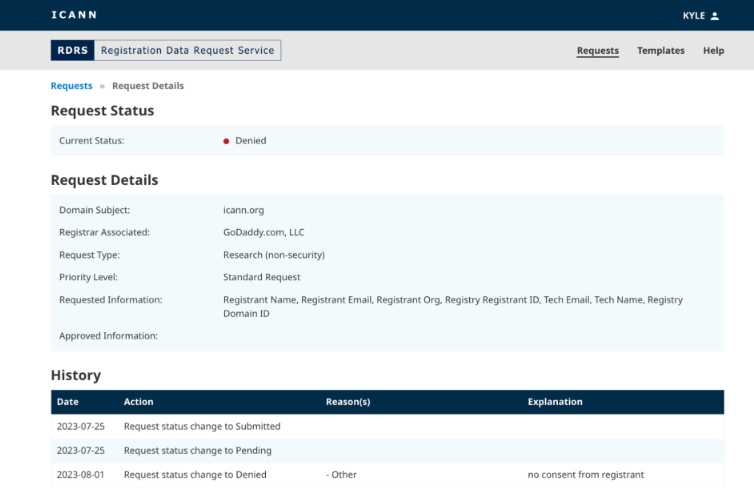ICANN Launches Service to Help With WHOIS Lookups
Krebs on Security 2023-12-06
More than five years after domain name registrars started redacting personal data from all public domain registration records, the non-profit organization overseeing the domain industry has introduced a centralized online service designed to make it easier for researchers, law enforcement and others to request the information directly from registrars.

In May 2018, the Internet Corporation for Assigned Names and Numbers (ICANN) — the nonprofit entity that manages the global domain name system — instructed all registrars to redact the customer’s name, address, phone number and email from WHOIS, the system for querying databases that store the registered users of domain names and blocks of Internet address ranges.
ICANN made the policy change in response to the General Data Protection Regulation (GDPR), a law enacted by the European Parliament that requires companies to gain affirmative consent for any personal information they collect on people within the European Union. In the meantime, registrars were to continue collecting the data but not publish it, and ICANN promised it would develop a system that facilitates access to this information.
At the end of November 2023, ICANN launched the Registration Data Request Service (RDRS), which is designed as a one-stop shop to submit registration data requests to participating registrars. This video from ICANN walks through how the system works.
Accredited registrars don’t have to participate, but ICANN is asking all registrars to join and says participants can opt out or stop using it at any time. ICANN contends that the use of a standardized request form makes it easier for the correct information and supporting documents to be provided to evaluate a request.
ICANN says the RDRS doesn’t guarantee access to requested registration data, and that all communication and data disclosure between the registrars and requestors takes place outside of the system. The service can’t be used to request WHOIS data tied to country-code top level domains (CCTLDs), such as those ending in .de (Germany) or .nz (New Zealand), for example.

The RDRS portal.
As Catalin Cimpanu writes for Risky Business News, currently investigators can file legal requests or abuse reports with each individual registrar, but the idea behind the RDRS is to create a place where requests from “verified” parties can be honored faster and with a higher degree of trust.
The registrar community generally views public WHOIS data as a nuisance issue for their domain customers and an unwelcome cost-center. Privacy advocates maintain that cybercriminals don’t provide their real information in registration records anyway, and that requiring WHOIS data to be public simply causes domain registrants to be pestered by spammers, scammers and stalkers.
Meanwhile, security experts argue that even in cases where online abusers provide intentionally misleading or false information in WHOIS records, that information is still extremely useful in mapping the extent of their malware, phishing and scamming operations. What’s more, the overwhelming majority of phishing is performed with the help of compromised domains, and the primary method for cleaning up those compromises is using WHOIS data to contact the victim and/or their hosting provider.
Anyone looking for copious examples of both need only to search this Web site for the term “WHOIS,” which yields dozens of stories and investigations that simply would not have been possible without the data available in the global WHOIS records.
KrebsOnSecurity remains doubtful that participating registrars will be any more likely to share WHOIS data with researchers just because the request comes through ICANN. But I look forward to being wrong on this one, and will certainly mention it in my reporting if the RDRS proves useful.
Regardless of whether the RDRS succeeds or fails, there is another European law that takes effect in 2024 which is likely to place additional pressure on registrars to respond to legitimate WHOIS data requests. The new Network and Information Security Directive (NIS2), which EU member states have until October 2024 to implement, requires registrars to keep much more accurate WHOIS records, and to respond within as little as 24 hours to WHOIS data requests tied everything from phishing, malware and spam to copyright and brand enforcement.